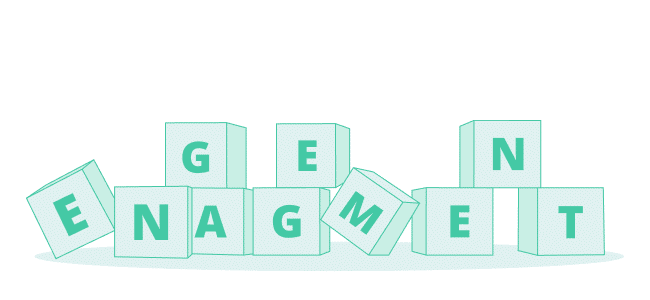You may primarily associate bullying with children and classroom environments.
But bullying occurs in particular (and unfortunately) also in adult workplaces.
Bullying is an abusive act that takes place repeatedly over a long period of time.
The Danish Working Environment Authority defines bullying as:
“It is bullying when one or more people regularly and over a long period of time – or repeatedly in a gross way – exposes one or more other people to abusive actions that the person concerned perceives as hurtful or degrading.”
Then we have the definition in place.
And so we have come to the conclusion that bullying is not just a simple argument or a form of disagreement between two parties.
And yet there are several gray areas. Because it will always be the subjective perception of the situation and the relationship that determines whether it is bullying.
And it is difficult.
Because people are different and we have very different limits.
What is purely sarcastic humor to the receptionist can be decidedly offensive behavior to the cleaning manager.
The Danish Working Environment Authority therefore attaches great importance to the quantity – i.e. how large a volume these actions constitute – how often they actually occur.
Isolated situations will rarely be categorized as bullying – depending on the severity of course.
Examples of workplace bullying could be:
– Spreading rumours
– That you consistently talk down to an employee
– That you deliberately give an employee a very large amount of work compared to the other employees
– That an employee is excluded from social events
– When an employee consistently undermines their manager’s authority
– Posting humiliating, offensive and threatening comments or images on social media
So yes, bullying can come in many guises and none of them are particularly fun for the recipient or for well-being in general.
The good news!
Fortunately, bullying can be prevented and reduced if all levels in your workplace take action.
Therefore, in our ‘Recommendations for action’, you get concrete tools to work preventively with bullying at the workplace’s 4 levels – Individual, Group, Management and Organizational level (IGLO).
In ‘Recommendations for action’ we go in depth with concrete recommendations for measures at each level.
One of the most important factors in relation to bullying is the conflict management itself.
Mapping bullying
In the first instance, you must have mapped out whether there is bullying at all – and if so, to what extent are we talking about it?
The best way to find out is via The Health and Safety Assessment, where there are specific questions regarding bullying in the workplace.
In our surveys at Woba, we often run the following question:
Have you experienced bullying at your current job within the last 12 months?
And if you answer yes to that question, you will be directed to this one:
Please write who you have been bullied by?
And that is precisely the procedure to map whether a bullying problem exists in the first place and in particular – WHO is the perpetrator.
Precisely anonymity is important here, as many will have serious concerns about answering this if they are not protected by anonymity.
It is a very vulnerable subject – and a very unsafe problem, which makes it even more important that you run the Health and Safety Assessment to identify any problems of a serious nature. And you can safely say that ‘bullying’ is.
But then, always make sure you have a question frame that includes direct contact with bullying.
What do our surveys show?
At Woba, we have so far run 420,980 surveys for our business customers.
Through this, we have come across countless cases of bullying. And it ranges widely. From small (innocent) remarks made in the middle of lunch to decidedly continuous condescending treatment of employees.
In fact, 54% of our surveys that show ‘offensive acts’ are related to bullying.
In the following, you will see a small selection of problems related to bullying:
– ‘You are not taken seriously by your colleagues when you are under stress’
– ‘A few colleagues who repeatedly become mocking or condescending if you express that you are busy or have too much on your ears.’
– ‘When everyday life becomes stressful, I quickly find that people let their frustrations spill over to other work groups in the company and that the tone becomes unpleasant.’
– ‘If deliberately skewed division of labor can be described as bullying? So big yes’
– ‘Extremely negative attitude from nearest manager, including harassing language, negligence, being ignored, quite simply the most terrible manager I’ve had in my entire career.’
– ‘Mean management! After 14 years I have lost my 4 day week. Must stay every Friday until 12. At the weekend, there is no possibility of restitution. Only have 1.5 days off at the weekend. Management has ruined my family life. All talk with management is a waste of time. The management has the power, but not the slightest competence. The management does not take responsibility for the employees. The employees are not treated fairly. Friend favors and ass-licking are the management’s specialty. Work assignments are distributed according to sympathy and not according to qualifications.’
– ‘There are some bullies, but I don’t let them get to me anymore. I mean we mostly help each other, but there is always that “one guy” that wants everyone to help him, and at some point starts demanding help disregarding your tasks.’
The quotes show the diversity clearly.
Bullying can be many different things and exist on many different levels.
That is why it is also important that you ask about the bullying itself in your survey.
Follow up with the question:
‘Describe the situation where you have felt bullied’.
In this way, you get to know immediately what the bullying really is about – and thus get a valid basis for future action plans and measures.
It is undeniably easier to take action against bullying when you know the specific scope and the specific situation.
It gives itself.
Manage the conflict
Bullying most often stems from some form of conflict.
And conflicts are almost inevitable in a workplace. It is therefore particularly important that conflicts are handled in a fair manner to avoid a possible escalation.
Conflicts that are handled fairly can lead to a better working environment with well-being, but conversely if the conflict is not handled fairly, it can lead to an unhealthy working environment with poor working relationships and increased sickness absence.
When you have to work effectively with the handling and prevention of conflicts, you need a targeted effort and a prioritization from all levels in your workplace.
Here you get concrete tools to work preventively with conflicts at the workplace’s 4 levels – also called the IGLO model:
At organizational level
Understand the problem before you solve it
If the top organizational level (top management, HR, EHS, Working Environment Organization etc.) is to find out how you can best handle conflicts more fairly, it is important that you, in the first instance, know whether it is a real problem for you.
A good tool to gain this insight is to use the results from theHealth and Safety Assessment or the Engagement Survey to assess and map whether it is a specific problem in the company.
Conclusion: It IS a real problem within our organization.
Well, from here it is necessary that the top management and the Working Environment Organization follow up and make a specific action plan which will be anchored locally to improve the situation.
Most importantly: Take the problem seriously. Because it IS serious when an employee feels directly bullied on the job!
At management level
Create dialogue about conflicts.
There are several things you, as a manager, can do when it comes to handling and preventing conflicts among your employees in a fair way.
Here is a list that you can be inspired by:
– Make it clear that you want to be involved early on when conflicts arise
– Talk about values and common ‘rules of life’
– Make room for diversity in the employee group
– Lead by example – and always try to handle conflicts constructively and fairly
– Take the initiative for a dialogue with the employee group about how conflicts are handled fairly
– Seek out the necessary knowledge about conflict prevention and handling, so that everyone feels that they are treated fairly without discrimination when a conflict arises
At Group level
Take care of the conflicts
As a group of colleagues, you have a great responsibility when it comes to handling conflicts fairly and, not least, preventing any escalation.
There are several things you should be aware of:
– Act constructively on conflicts when they arise
– Avoid guilt, shame and punishment
– Help each other find useful ways to de-escalate the conflict
– Never take sides, but try together with the parties involved to resolve the conflict without discrimination
– Find different values or ‘rules of life’ that describe how you as colleagues speak and behave towards each other, as well as how you handle and read conflicts in the most fair manner
At the individual level
Pay attention to your behavior
If you experience the prelude to a conflict, or perhaps find yourself in a conflict with one or more colleagues, it is important that you go to your union representative, working environment representative or immediate manager immediately.
Are you in a conflict yourself?
Then you must pay attention to the following:
– Keep the focus on the matter – on what ‘it’s about’
– Try to maintain a constructive and proper tone
– Explore solutions that both parties can be satisfied with
– Seek support from colleagues who may be able to help you see some other perspectives on the matter
– Be open, be a listener and try to put yourself into the other’s perspective
It is never easy to find yourself in a conflict – and certainly not at work!
Despite the discomfort, it is just so extraordinarily important that you do something active to get it resolved – as soon as possible.
Otherwise, you risk that the conflict will poison the relationship – and the entire working environment – over time.
Example of an action initiative from the real world
If you use Woba as a platform, we have a whole action plan module to fill out.
And when your surveys have been run through and all risk areas have been located, we automatically also provide recommendations for action measures that you can work from and implement.
Drawing up action plans and specific action measures is a requirement for your Health and Safety Assessment to be legally binding.
But what is more important, it is also essential for your working environment, general well-being and employees’ well-being and health.
Because problems such as bullying MUST be taken seriously and dealt with.
A concrete action initiative could, for example, look like this:
Problem:
‘In continuation of our most recent Health and Safety Assessment, an expression has been given that we have a case of bullying in the company.’
Solution:
‘As management, we clearly distance ourselves from being bullied in the workplace. We must respect each other and be respected for who we are – therefore we must also have a culture of well-being, where we ensure that if you feel bullied, that we can talk about it, as well as if someone witnesses bullying actively take steps against this . We define a clear bullying policy, which is presented at an internal meeting.
We recently had a course for selected employees in relation to getting to know each other’s types, and learning to understand why you act the way you do.
We are trying to spread the action from here to a course for the entire staff.’
Here it is one of our customers who has drawn up a plan for the problem and implemented a concrete action plan.
From here, an important step in the process is the follow-up work. Because do the action measures really work as intended?
Run a pulse survey after a few months and see the effect (or lack of effect) on the work environment.
Perhaps the surveys have already worked and well-being has increased. Or maybe it is not the most effective action plans you have implemented – well, then you become much wiser and then it is simply back to the drawing board in relation to a new direction.
No matter what, intensive well-being work – in particular when it concerns bullying – will show the employees that they are taken very seriously and that their well-being is a priority from the management’s perspective.
Because no one deserves to be bullied.
Neither at home nor at work.











